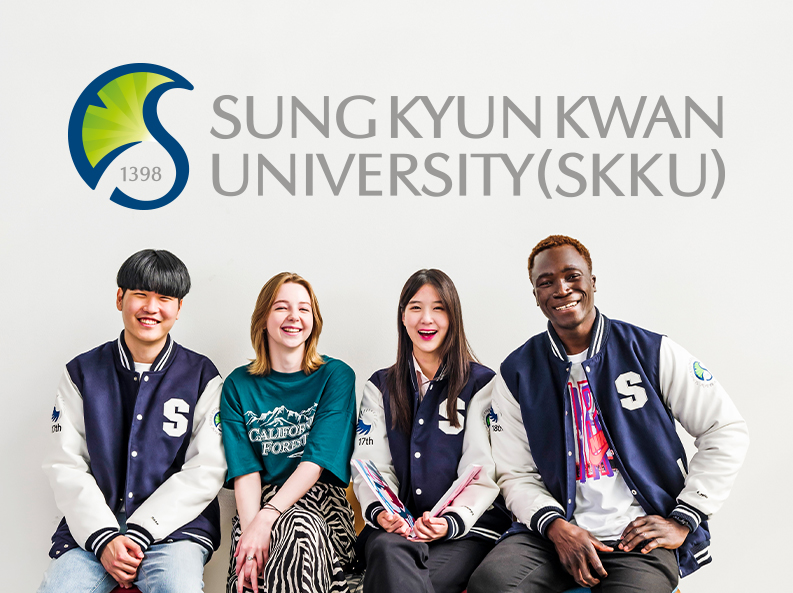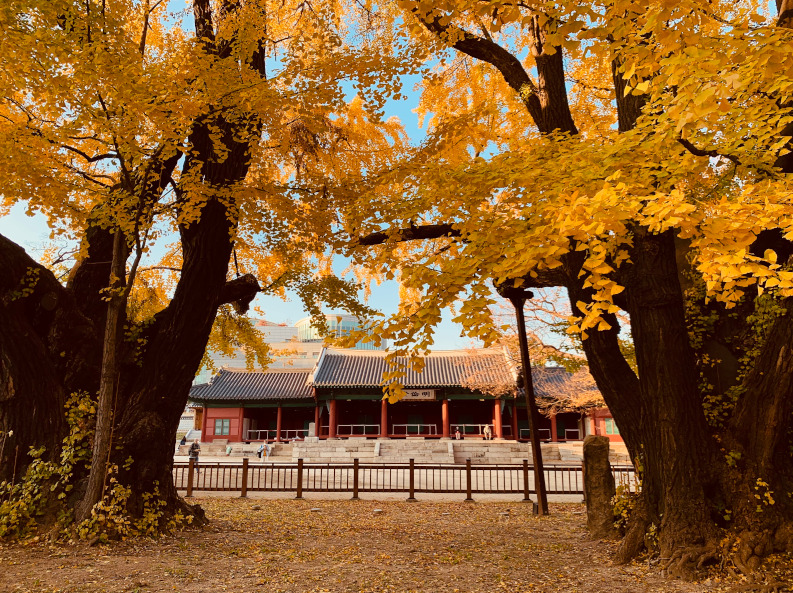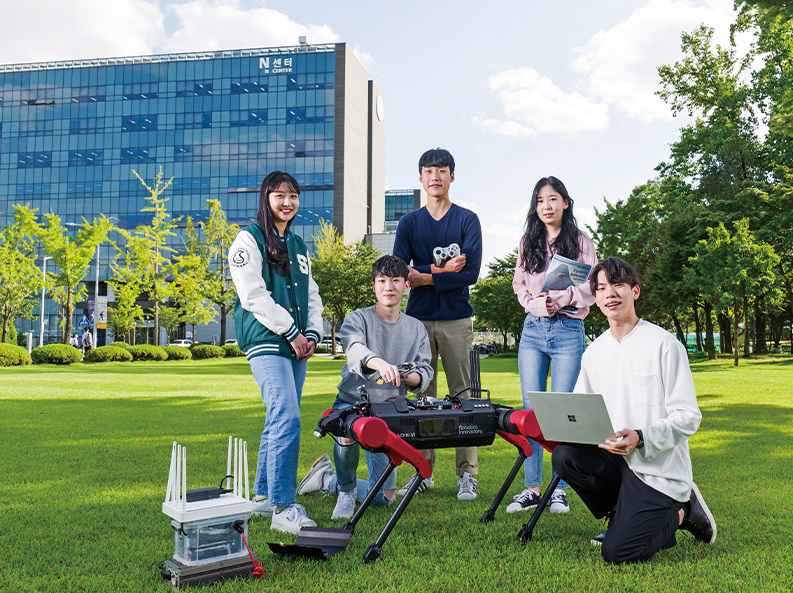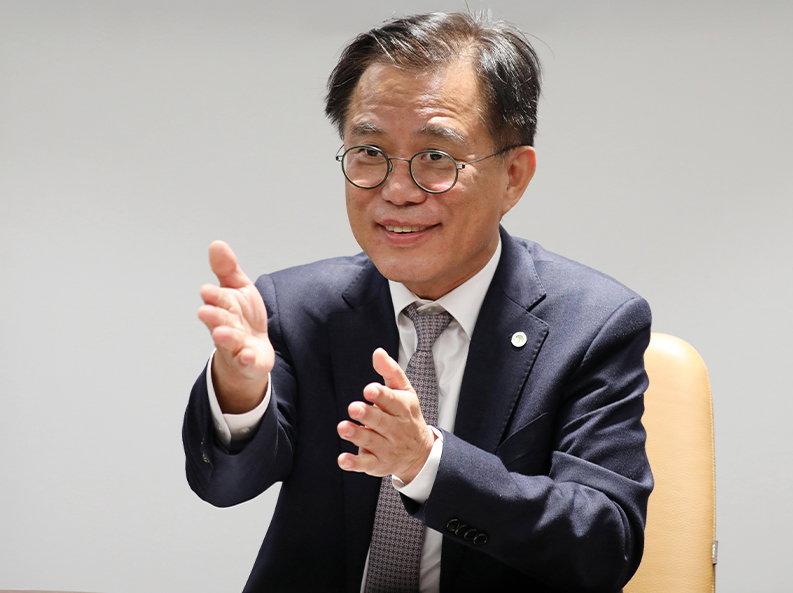As South Korea stands out for its high university enrollment and graduation rates, Sungkyunkwan University continues to focus on fostering talent for the long term.

Korean universities have traditionally been the driving force behind the country’s high-tech talent pool, helping South Korea become a leader in various industries. However, the country now faces a series of significant challenges. Beyond limited globalization of its labor force compared to other nations, a demographic shift is expected to create a labor shortage of 7.4 million workers by 2040. How can Sungkyunkwan University contribute to addressing Korea's current challenges and prepare the country for the future?
If you ever have a chance to visit rural areas in Korea, you’ll find many industrial zones with what we call "3D" factories, where most workers come from abroad. This is an essential, yet often overlooked, part of our nation. In the past, when I visited these areas, local employers struggled to recruit blue-collar workers. Those who came often found it challenging to adapt to Korean culture. Today, things have changed. Both national and local governments now encourage foreign workers to bring their families when they come to Korea. However, even after inviting, educating, and graduating them from our universities, they face the challenge of finding jobs and adapting to life in Korea. This is the current situation.
At Sungkyunkwan University, we have two main strategies for attracting international students. Nationally, the target is to attract 300,000 international students by 2027, but Sungkyunkwan has a unique approach to this goal. We can describe it from two perspectives:
First, at the undergraduate level, we aim to bring in students interested in high-tech industries and support their entry into these fields by helping them secure employment after graduation. For master’s and Ph.D. programs, our goal is to attract specialized talents who can contribute to global institutions. Rather than simply increasing the number of international students, we are focused on attracting those with expertise. Given our educational infrastructure and other constraints, we plan to grow our international undergraduate population from 3,000 to around 4,000. For our master’s and Ph.D. programs, we are prioritizing international students in fields like medicine, biotechnology, engineering, and natural sciences.
We are also committed to diversifying our international student body. Currently, about 70 to 80% of our undergraduate international students are from China. Rather than reducing this group, we aim to increase our numbers from Southeast Asia, Central Asia, and some Eastern European countries to create a more balanced international community. Interestingly, we’ve seen a growing number of Japanese students choosing SKKU because of our high rankings in international assessments like QS or Times. For them, a high-ranking Korean university often represents a more attractive option than a lower-ranked Japanese institution, especially since the cultural familiarity and short travel distance make studying here convenient.
In summary, we are focusing on the quality of education and inviting talented students at both undergraduate and graduate levels. Our goal is to make Sungkyunkwan University a welcoming place for international talent to excel academically and enjoy their experience in Korea.
With SKKU’s longstanding record of industrial collaboration, such as your 30-year partnership with Samsung Group—particularly with Samsung SDI and Samsung Electronics—this ecosystem you're describing seems well-suited to help international students transition into Korea's high-tech industry. Could you elaborate on the framework you’re building to ensure international students not only benefit from classes but also gain access to future job opportunities?
Few students immediately find positions in high-tech industries right after graduation, as opportunities are limited. However, we are in constant discussions with industry leaders and HR departments, who are very eager to find well-qualified international students. During my visit to Vietnam, I noticed how companies like Samsung, Hanamicron, and Hyundai Motors support academic institutions there by recruiting and training local talent for their factories. Similarly, at SKKU, we have agreements with Samsung Electronics through which the company provides scholarships to students in the Department of Semiconductor Systems Engineering. In return, these students join Samsung Electronics after graduation. Such partnerships reflect the high demand for skilled talent. So why not provide these opportunities for international students here in Korea?
To that end, we offer summer and winter internships to both undergraduate and graduate students. Through these programs, industries gain access to talented individuals, and students benefit from practical experience, creating a robust talent pipeline. This system is available not only for Korean students but also for international students. We’re expanding and strengthening this ecosystem, although it will take time to fully develop. Given Korea’s demographic challenges, building a reliable talent pool is essential.
Another interesting aspect of Korea is the strong cultural preference for medical school. Each year, the top 2-3% of Korean students tend to pursue medicine, often encouraged by their families, even if their interests or aptitudes lie elsewhere. This trend has led to fewer talented students entering fields like social sciences, humanities, natural sciences, engineering, and biotechnology. If we cannot attract enough top-tier domestic students to these fields, we need to recruit highly qualified students from abroad. That’s why, along with providing strong academic programs, we’re also offering extracurricular activities and internships to ensure students gain comprehensive experience. Internships, in particular, are a valuable way to evaluate students' abilities, regardless of nationality.
In advanced research institutes, for example, there used to be a significant number of Russian scientists, and we now need to attract more international talent to fulfill similar roles. SKKU is focused on preparing for this by providing tailored education and training programs for international students.
SKKU also operates its own research center, but it's noteworthy that less than 30% of our Master’s and Ph.D. students are SKKU graduates; the remaining 70% come from other institutions. Around 20% of these graduate students, especially in engineering and natural sciences, are exceptionally talented. For instance, I’ve had brilliant Indian and Chinese students who completed their Ph.D.s under my guidance. Many have gone on to become professors in India or secure prestigious positions in China. This success demonstrates the positive societal impact our international graduates have, reinforcing our commitment to recruiting quality international students and expanding their opportunities at SKKU.

In discussions with other universities, we've heard that AI might be used to design customized classes and tailored exams for students. The Korean government is also planning a significant investment of 95 billion KRW by 2028 to promote AI advancements. How do you view the impact of digital technology and AI in education, and how is SKKU preparing for and integrating these technologies?
These days, everyone is talking about AI in higher education, but in my opinion, actual progress has been limited. I often call this situation "NATO"—"No Action, Talk Only." This highlights how challenging it is to truly integrate digital technologies and AI into higher education. Broadly, AI can be applied at three levels: education, administration, and research.
In research, AI tools have already become integral, regardless of one’s field of study. Professors and researchers use AI systems like ChatGPT to conduct surveys, process translations, gather data, and summarize information. Experts in their fields can assess the quality of the AI-generated data and quickly discern whether it’s accurate, so there’s little issue there. However, education and administration present different challenges. Many people see ways to increase efficiency, but using AI in education is more complex.
Last year, I encouraged the academic affairs team to explore using AI in classes. Some professors in social sciences successfully experimented with AI-assisted lectures. This year, we’re planning to expand AI integration in more courses. Since we already have class materials, we’ll train AI systems with those resources, and if needed, we may purchase additional content from platforms like Coursera to further enhance the AI’s knowledge. This way, students can consult the AI bot first and receive immediate answers. If the AI’s response is unsatisfactory, we’ll have Q&A sessions with professors. This is one of several ways AI can be useful in education.
Additionally, I sometimes ask professors to create new courses. This is a time-consuming process and can be demanding, as they must research, design materials, and so on. To support them, I proposed an idea to the academic affairs office: when new professors join, we’ll waive their teaching requirements for the first year to give them time to develop a new course in their specific field. In one case, a professor who completed a Ph.D. overseas based their course on one they took during their studies. This type of replication happens across various departments, but we want to encourage originality. Combining professors' expertise with AI-generated content can lead to innovative classes. We’ll pilot this system next year and see how it unfolds, removing the immediate teaching load for new professors to allow them time to develop impactful, AI-enhanced lectures.
Another challenge I’d like to address is class enrollment. In Korean universities, courses with fewer than 10 students typically get canceled. We’re exploring ways to keep these smaller classes, as they often bring unique value. With professors' original contributions combined with AI, we hope to avoid cancellations and build engaging, sustainable courses. We plan to launch these AI-integrated classes next year and will share the results as we learn more.
To clarify, does the one-year exemption from teaching to prepare new courses start next year? Have any of these courses begun yet?
Not yet. Typically, professors teach a reduced load in the first semester—three credits, or three hours per week. By the second semester, they usually teach six hours, or slightly fewer. They are required to meet a certain credit load per year, but under our new system, first-year professors will be fully exempt from this requirement starting next year. To support this shift, we’re preparing supplementary action plans to ensure a smooth transition.

Founded over six centuries ago, Sungkyunkwan University blends its rich history and traditional Korean culture with innovative programs in fields like AI, semiconductors, and secondary batteries. Since becoming president this year, what is your vision for the university's future? Additionally, are there any new departments, programs, or even a campus that you plan to establish?
From the beginning of my term, I’ve focused on addressing global issues that impact the future of society and humanity as a whole. Rather than concentrating on short-term gains, I believe in the saying, “A bird that flies higher can see farther.” Currently, university presidents face many pressures, especially regarding rankings. Universities like MIT and Harvard don’t concern themselves much with rankings, but newer, rapidly developing universities are highly competitive in this area, especially those ranked between 30th and 70th. Three or four years ago, we were ranked around 82nd globally, and this year, we are at 122nd. However, I always encourage our professors not to fixate on rankings or publication counts. Instead, I urge them to focus on making impactful contributions to their fields and to society—developing technologies that ultimately benefit humanity and aim for leadership in those areas. My vision is to foster a long-term, broad-minded perspective that positions SKKU as a global leader serving and supporting societies around the world.
At the same time, as material wealth has grown, society seems to have become poorer in spirit. One reason for this is that universities often fail to fulfill their broader mission. Financial resources are essential, but they are not the entire picture.
In response to your second question, we have recently launched several departments that focus on cutting-edge fields, including secondary battery technology, meta-biohealth, advanced pharmaceutical manufacturing, and a Department of Quantum Technology. The quantum department encompasses quantum computing, quantum sensing, and quantum communication at the undergraduate level. For graduate studies, we emphasize interdisciplinary convergence, blending technology with humanities, social sciences, Confucian studies, Korean history, and Korean politics, all integrated with IT.
In the United States, students typically have the freedom to choose their major after enrolling in a general program. In Korea, however, students usually enter university with a broad departmental affiliation, such as the School of Social Sciences, School of Economics, or School of Engineering. By their sophomore year, they select a specific major. We aim to give students more flexibility in choosing their academic paths. Additionally, in line with Ministry of Education requirements, we are implementing a "free major" program similar to the U.S. model. This system allows students to enter university without a declared major, take courses for a year, and then select their preferred field of study.
You mentioned increasing flexibility by reducing the minimum required credits for any major from 60 to 40. Additionally, you've introduced interdisciplinary convergence between departments, such as chemistry and electronics, which is critical in many industries. How do you believe this approach will benefit the students, researchers, and professors at SKKU compared to more traditional systems?
This new system will undoubtedly benefit everyone—students, researchers, and professors—especially when it comes to advancing research across departmental boundaries. Today’s problems are complex, requiring a blend of diverse expertise. Communication skills across disciplines are crucial, and fostering them early is key. Unfortunately, the Korean education system has traditionally been quite rigid, with strong silos that start even in high school, which is a significant challenge.
What’s interesting to me is that students often feel a strong need to identify with a specific department early on, as it provides a sense of belonging and stability. I understand this—it connects them to peers with similar experiences and creates a support network. But I encourage them to look beyond these boundaries and explore freely across departments. They’ll naturally build connections and networks over time, so there’s no need to feel restricted to one affiliation from the start. Korean society is shifting away from traditional, department-based affiliations to a model that allows more academic freedom and interdisciplinary exploration. This is precisely what I’m trying to achieve with our new system.
We’ve reduced the core credits for each major and expanded students’ freedom to choose from a diverse array of courses. Since students may be unfamiliar with this level of choice, we offer a variety of specialized “tracks”—structured series of courses that guide them through specific fields. For instance, we have a secondary battery track for undergraduates that spans five to six classes across three departments. Similarly, we offer an e-mobility track, which includes courses in mechanical engineering and control systems. Students are free to select tracks that align with their interests. I’ve encouraged the deans to create as many convergence tracks as possible, allowing students to experience multiple disciplines.
This approach also opens up opportunities for students from different backgrounds to connect, exposing them to varied perspectives and ways of thinking. For example, students in sociology, social science, and psychology may approach problems entirely differently from those in engineering. These diverse interactions enrich the learning environment, fostering a deeper understanding of complex issues.

Ji-Beom Yoo, President of Sungkyunkwan University
SKKU has established 549 partnerships across six continents to promote student exchanges and research collaborations. To further support international students’ experiences in South Korea, SKKU has launched dual degree programs with institutions such as the University of South Carolina, University of Houston, Pennsylvania State University, University of Texas at Dallas, and Nanyang Technological University (NTU) in Singapore. What role do partnerships and MOUs play in your university’s strategy? How important is it for SKKU to grow and become a leader internationally?
Every university works to build partnerships globally, but the approach has evolved significantly. About 20 years ago, it was common in Korea to believe that international collaboration was achieved simply by signing MOUs. Many university offices, including ours, had stacks of MOUs that were largely symbolic. At the time, we jokingly called Korea the “kingdom of MOUs.” Now, however, the focus has shifted to meaningful actions in research and education. At SKKU, we’ve signed MOUs with over 500 universities, but our strategy has moved toward building “hub” partnerships.
For instance, in the U.S., we select one university per region, based on their history and prior activities. For example, we partnered with Penn State on the East Coast and UC Irvine on the West Coast. We launched a dual-degree MBA program with Indiana University, where professors from both institutions exchange teaching responsibilities, as well as with a program in South Carolina. In China, we have a close relationship with Fudan University in Shanghai. This hub-based approach, driven by shared interests and professor networks, is how we select and deepen partnerships across continents.
We are also working on an alliance for virtual education. In this model, SKKU collaborates with universities in the U.S. or Hong Kong, with professors co-teaching classes. For example, SKKU professors may teach one week, while professors from the partner university teach the next. Students from both institutions participate simultaneously, online, and often work together on team projects. At the end of the semester, students gather in one country to finalize the project, present, and receive feedback. This kind of educational collaboration is invaluable because it merges perspectives and skills in a real-world context.
Research collaboration is often facilitated directly by professors, who frequently collaborate internationally within their fields. SKKU also organizes the Sungkyun International Solar Forum, founded 12 years ago. In its early years, we invited renowned experts in solar cell research, helping one of our professors gain global recognition in that area. This forum has led to many co-authored papers and journals in fields like solar cells and silicon-based compounds. Some prominent academics even expressed disappointment when they weren’t invited. This type of engagement—through forums, seminars, and specialized conferences—has become much more frequent and impactful.
In May, I attended a conference in Stockholm with professors from SKKU, Seoul Metropolitan University, and Korea University, joined by 10-15 Swedish speakers, including three Nobel Prize nomination committee members in physics and chemistry. These focused, regional engagements reflect true collaboration. The quality, not quantity, of partnerships is what drives our internationalization strategy. Concentrating on specific regions and disciplines strengthens our collaborations and enhances our impact.
For example, SKKU’s strength in Confucianism and Asian studies aligns well with current European interest in K-culture. Heidelberg University in Germany has an excellent Asian Studies program, and we partner with them not only in Korean language studies but also in history, politics, and culture. One of our faculty members studied at the Free University of Berlin and later joined the Brandenburg Academy of Humanities, which has strengthened our networks. Since SKKU aims to excel in humanities and social sciences, we partnered with Heidelberg and other European universities, like those in the Netherlands and France, where we find complementary expertise in these fields.
Let’s say we come back in 1-2 years. What would you like to look back on as the President?
In 1-2 years, my hope is to plant the seeds for a vision that SKKU will continue to nurture and achieve in the years ahead. Ideally, 5-10 years from now, my successor will look back and recognize that the progress they’re making began with the groundwork I established. If my successor sees my efforts as the foundation for their accomplishments, that would be incredibly rewarding to me.
I only have 3-4 years in my term, which is a relatively short time to achieve substantial, lasting goals. When people attempt to make sweeping changes in a limited timeframe, they often end up making mistakes instead. So rather than focusing on immediate results, I want to launch and carefully cultivate meaningful initiatives, then pass them on so my successor can carry them forward and fully realize their potential. And if, in those moments of progress, my successor remembers me, I would feel deeply honored.
For more information visit: https://www.skku.edu/eng/
0 COMMENTS